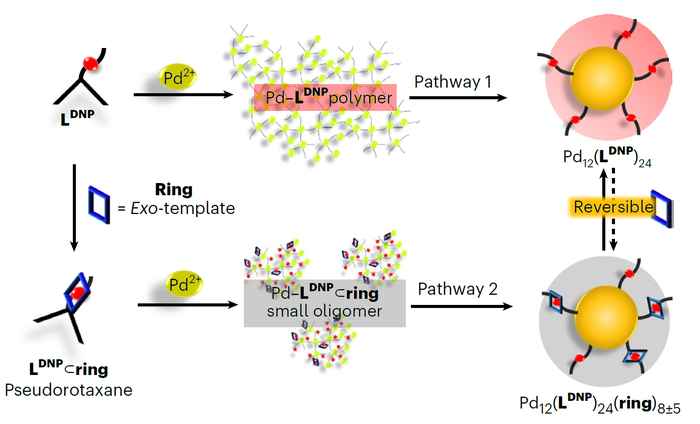Controlling the pathway of self-assembly using an exo-template
12 May 2025

The self-assembly of large molecular structures typically suffer from ‘pathway complexity’ where formation of the thermodynamically most stable product is frustrated through competing kinetic pathways that result in metastable or kinetically trapped non-equilibrium assemblies. In analogy to the use of templates in covalent chemistry, also in self-assembly processes templates can be used to modulate the pathway and direct the synthesis outcome. Molecular building blocks that are ‘wrapped around’ an endo-template, which is built-in to the final product, is a well explored strategy. However, for larger, complex self-assembled structures such template approaches are not an option.
In their paper in Nature Chemistry, the Amsterdam researchers now present a kinetic exo-template by pseudorotaxane formation for the multicomponent self-assembly of Pd12L24 nanospheres. Whereas previously positive and negative kinetic templating has been reported that respectively stabilizes or destabilizes kinetic barriers, the new exo-template approach now adds the alternative strategy of kinetic templating that destabilizes stable intermediates. The researchers redesigned the building blocks that typically form cuboctahedral Pd12L24 structures—based on insight into the formation kinetics—to utilize pseudorotaxane structures to mould an alternative pathway towards the desired Pd12L24 nanosphere.
This alternative pathway prevents the formation of longer polymer intermediates, which at lower temperatures are kinetically trapped intermediate states. These type of pathway engineering approaches are important to allow the construction of larger, more complex functional self assembled molecular structures.
Abstract, as published with the paper
Selective formation of multicomponent structures via the self-assembly of numerous building blocks is ubiquitous in biological systems but challenging to emulate synthetically. More components introduce additional possibilities for kinetic intermediates with trap-state ability, hampering access to desired products. In covalent chemistry, templates, reagents and catalysts are applied to create alternative pathways for desired product formation. Analogously, we enlist exo-templating to mould the formation of large, multicomponent supramolecular structures. Specifically, a charged ring docks at 1,5-dioxynaphthalene stations within exo-functionalized building blocks to promote formation of cuboctahedral Pd12L24 nanospheres via exoskeletal templating. With the exo-templating ring present, nanosphere formation occurs via small Pdx–Ly oligomers, while in the absence of the ring a Pdx–Ly polymer resting state rapidly evolves, from which nanosphere formation occurs slowly. We demonstrate a form of kinetic templating—via intermediate destabilization—resembling properties observed in catalysis. Importantly, unlike typically employed endo-templates, we demonstrate that exo-templating is particularly suited for larger, complex, self-assembled structures.
Paper details
T. Bouwens, E.O. Bobylev, L.S.D. Antony, D.A. Poole III, E. Alarcón-Lladó, S. Mathew & J.N.H. Reek: Exo-templating via pseudorotaxane formation reduces pathway complexity in the multicomponent self-assembly of M12L24 nanospheres. Nature Chemistry, published xx May 2025, DOI: 10.1038/s41557-025-01808-w
See also
Research group: Homogeneous, Supramolecular and Bio-Inspired Catalysis